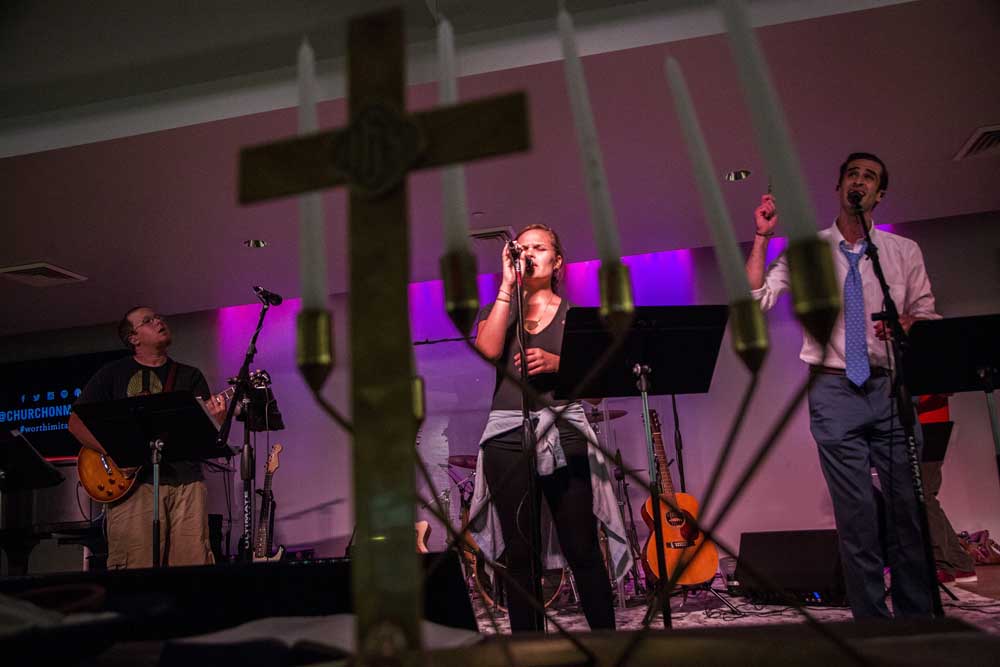In North Carolina, churches reach out to younger crowds
Published 12:00 am Saturday, November 5, 2016

- Travis Long / Raleigh News & Observer / Tribune News ServiceFrom left, Vander Warner, Taylor Meadows and TomTom Roach rehearse during a band practice at the Church on Morgan in downtown Raleigh, North Carolina. Church on Morgan has a thriving number of millennials in its congregation.
RALEIGH, N.C. — For more than 200 years, members of Edenton Street United Methodist Church have worshiped from wooden pews that are bathed in sunlight filtering in through stained-glass windows.
Six blocks away in downtown Raleigh, some worshipers now gather at the church’s second campus: a modern white building with a garage door that opens to allow sounds from the contemporary band to stream out.
Church on Morgan is a more laid-back version of Edenton Street United Methodist, which dates back to 1811. Edenton church leaders say they created the new campus to appeal to the rising number of young people who live downtown. Another nontraditional campus is planned for Southeast Raleigh.
“We wanted to connect with a demographic we didn’t see represented, to connect with members right outside our door,” said Justin Morgan, pastor of Church on Morgan. (The church was named for its location, Morgan Street, not for the pastor.)
More than 1,000 church-goers attend Sunday services at the main Edenton Street church.
Church on Morgan, which opened last fall, attracts about 400 people each week. It recently launched a second service and meets at 9 a.m. and 11 a.m. on Sundays. It also hosts community events, concerts and pop-up food festivals. This month, it served as a venue for the Hopscotch Music Festival.
“We’re trying to become a much more diverse church and contextualize to the neighborhoods we find ourselves in,” Morgan said.
Even so, he said Church on Morgan is not “hipster church” with big plans to be cool.
Some traditional churches across the United States have been trying to make services more appealing to a younger crowd, especially as millennials pull away. In many cases, robed choirs have been replaced with rock bands, and pews have given way to auditorium seating.
But instead of bringing younger people in, those efforts can push them away, Morgan said.
“Millennials can smell that stuff from miles away,” he said. “You assume that church should be alternative. You’re not going to church to hear a great band, you’re going to church because you’re interested in something transcendent and spiritual.”
Taylor Meadows, a 29-year-old social media manager in Raleigh, bounced around to different churches until she found Church on Morgan in 2013. Back then, the group met informally and didn’t yet have a name.
Meadows said she had always watched pastors skeptically, questioning how they lived their lives during the week, and not just on Sunday mornings. She wanted community and authenticity. Now she sings in the band at Church on Morgan, where participants wear jeans and T-shirts.
“Church on Morgan is not trying to be the next best thing,” Meadows said. “When churches focus on trying to be hip, it takes away from the true mission of the church. Church on Morgan is focused on bridging divides in the community, not on being cool.”
Declining numbers
The number of people who identify as Christian in the United States is declining, especially among young adults, according to the Pew Research Center.
In 2014, 56 percent of people ages 18 to 24 identified as Christian, while 36 percent were not affiliated with an organized religion. Among people ages 25 to 33, 57 percent identified as Christian and 34 percent identified as not affiliated.
In contrast, 85 percent of people born between 1928 and 1945 identified as Christian, and 11 percent were not affiliated with a religion; 78 percent of baby boomers identified as Christian, and 17 percent were not affiliated.
Traditional Christian churches, particularly those with aging populations, can struggle to attract new members.
“It’s one of the main topics of discussion among pastors and church leaders,” said Darnell Dixon Sr., senior pastor at Bible Way Temple, a predominantly African-American church in Southeast Raleigh.
Many young church members leave for college and don’t return to church services, Dixon said. There are also more options to worship from home, through online services and sermons.
“Coming to a physical church is not a part of millennials’ religion experience,” Dixon said. “They don’t aspire to being active in church.”
In an effort to attract young people who don’t want church to last for hours, Bible Temple Way started 60-minute “express services” on Sundays.
“You have to make some concessions to reach people,” Dixon said.
About half the congregation at Sanctuary International Fellowship Tabernacle, a nondenominational church with 20-50 members meeting in Raleigh, are millennials, said Apostle Lee Ann Marino.
The church hasn’t added a coffee shop or light show to wow crowds, but Marino said she makes it a point to include in her sermons current events and topics that are relevant in young people’s lives.
“We need to take the issues that millennials feel are important seriously,” she said.
Catholic churches have also struggled to attract young parishioners, but no one should expect to see contemporary bands at Mass, said Michael Bayer, senior director of youth ministry for the Diocese of Raleigh.
“I think that millennials really crave authenticity,” said Bayer, 33. “When young adults show up to church, they’re looking for something real, not faddish. The fact that the Catholic Church has wooden pews, handbells, communion … there’s something very real about Catholic Mass.”
Celebrating neighborhoods
In January, Edenton Street United Methodist plans to open a campus in Southeast Raleigh, an area with a strong African-American history. Recently, the area has been seeing changes as more young white families move in.
“People only know Southeast Raleigh based on need,” said campus pastor Lisa Yebuah. “It’s synonymous with poor and black – that’s not it.”
Yebuah sold her home in North Raleigh last year and moved to Southeast Raleigh to live in the neighborhood she would serve.
The differences were striking right away, she said. In North Raleigh, Yebuah lived near two Starbucks shops. Several grocery stores and restaurants were nearby. Southeast Raleigh has fewer options.
“There might be two Raleighs, and that’s not fair,” Yebuah said.
But she said she’s not trying to “save” the neighborhood. Rather, she wants to celebrate it, and she hopes others will join her.
Church leaders are still looking for a site for the campus. In the meantime, those planning to attend meet at the main church’s youth center on Jones Street.
“There are certain neighborhoods in Raleigh that are so storied that nobody knows about. I don’t want Raleighites to just love downtown,” Yebuah said. “The thing that brings me the most joy is the opportunity to celebrate and highlight one of the most dynamic areas of Raleigh.”








